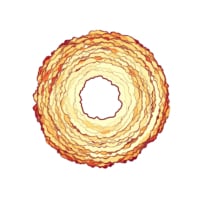
Researchers have succeeded in self-assembling polymers that are a thousand times bigger than molecular polymers, but which still follow the same laws of statistical physics. Unlike molecular polymers, however, these colloidomers, as they are called, are reconfigurable because the monomers that make them up are linked together via DNA molecules. The freely-jointed colloidal system, which is an example of self-assembly on the length scale that biological life assembles itself, might be used to make materials that continuously reassemble into new structures in response to a predefined trigger, such as a temperature change.
Designing materials that can be preprogramed to reconfigure themselves into new structures is one of the important goals of modern polymer science. A team of physicists and mathematicians led by Jasna Brujic of New York University has now taken an important step forward in this direction by making reconfigurable, freely-jointed linear and branched colloidomer chains from micron-sized droplets of PDMS (suspended in water) linked together with DNA molecules. The chains can be repeatedly dismantled and rebuilt by simply heating them up and cooling them down.
“Each droplet-droplet bond contains a few thousand links,” explains Brujic, “so controlling the number of DNA molecules governs the number of bonds the droplets can make.” When the system is heated, the DNA melts and the chains dismantle. The structures then spontaneously reassemble once they have cooled down again.
The researchers say they have succeeded in fabricating more than 22,000 colloidomers using their technique. The colloidomer chains are between 2 and 20 droplets long.
“Extremely floppy”
“These polymers are extremely floppy on the level of single droplets,” Brujic tells Physics World. “We followed their configurations in space and time and found that all chain configurations are equally likely to form – there are no preferred angles. This is why we call them freely-jointed.”
“This behaviour is very much like that of molecular polymers but unlike these, the colloidomers can be repeatedly assembled and disassembled under temperature cycling, allowing for reconfigurable, responsive matter.”
Such reconfigurable polymers could be useful for making amorphous materials with switchable viscoelastic properties, for example, says Brujic. “If you could control the valence of the constituent molecules to make four bonds for every droplet, for instance, and you allowed the resulting emulsion to crystallize, you might be able to make a ‘mayonnaise-like’ diamond lattice, which would be exciting. What is more, since these droplets are similar in size to the wavelength of light, such a ‘soft diamond’ could have novel optical properties too.”

Simple spectroscopic technique to study polymer behaviour at interfaces
The team, which includes researchers from the Physics Department and the Courant Institute of Mathematical Sciences at NYU and the Department of Phyics at Sapienza Universita’ di Roma, says that it would now like to apply its technique to proteins.
“We would also like to provide the colloidomers with different flavours of DNA along the chain, which will allow them to fold into predesigned structures,” says Brujic. “Such a system would open the way to programmable design.”
The freely jointed polymers and their behaviour are detailed in Physical Review Letters 10.1103/PhysRevLett.121.138002.



